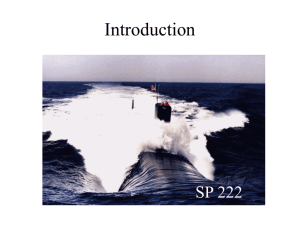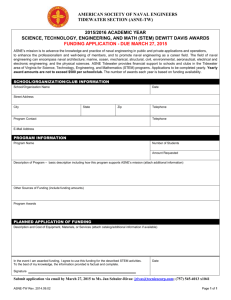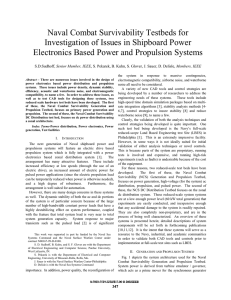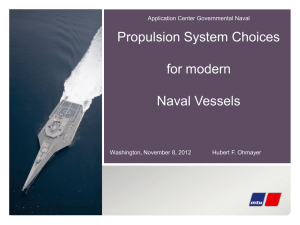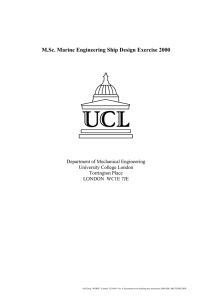United States Naval Academy Mechanical Engineering Department Catalog Description:
advertisement
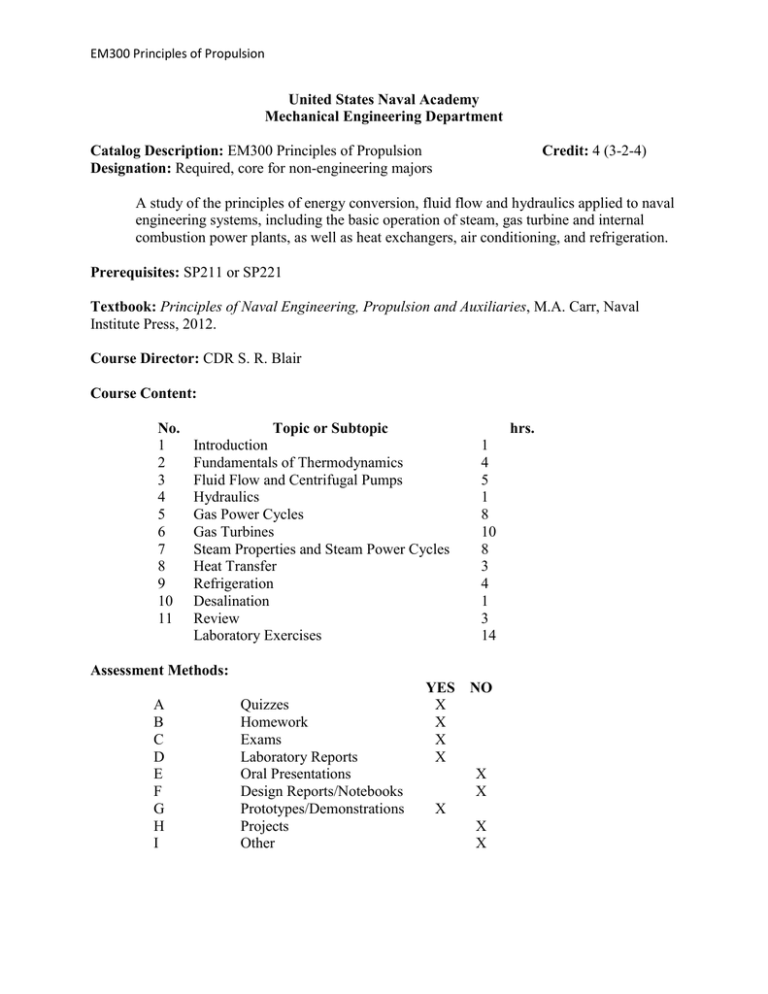
EM300 Principles of Propulsion United States Naval Academy Mechanical Engineering Department Catalog Description: EM300 Principles of Propulsion Designation: Required, core for non-engineering majors Credit: 4 (3-2-4) A study of the principles of energy conversion, fluid flow and hydraulics applied to naval engineering systems, including the basic operation of steam, gas turbine and internal combustion power plants, as well as heat exchangers, air conditioning, and refrigeration. Prerequisites: SP211 or SP221 Textbook: Principles of Naval Engineering, Propulsion and Auxiliaries, M.A. Carr, Naval Institute Press, 2012. Course Director: CDR S. R. Blair Course Content: No. 1 2 3 4 5 6 7 8 9 10 11 Topic or Subtopic Introduction Fundamentals of Thermodynamics Fluid Flow and Centrifugal Pumps Hydraulics Gas Power Cycles Gas Turbines Steam Properties and Steam Power Cycles Heat Transfer Refrigeration Desalination Review Laboratory Exercises hrs. 1 4 5 1 8 10 8 3 4 1 3 14 Assessment Methods: A B C D E F G H I Quizzes Homework Exams Laboratory Reports Oral Presentations Design Reports/Notebooks Prototypes/Demonstrations Projects Other YES NO X X X X X X X X X EM300 Principles of Propulsion Course Outcomes1 Communicate technical information using proper terminology, units, and ranges of values. Apply analytical 1. 2. 3. 4. 5. 6. 7. 8. 9. problem solving skills and unit analysis to evaluate technical information. (A,B,C,D) Apply the First Law of Thermodynamics and the Continuity concept to solve fluid flow problems. Apply the concepts of Head Loss, Pump Head, and mechanical power to determine major and minor head losses, pump performance, and power requirements. (A,B,C,D) Apply Pascal’s Law, the Ideal Gas Law, and the principle of Continuity to evaluate operation of hydraulic and pneumatic systems. (A,B,C) Identify the basic components of Reciprocating Engines and describe the operation of both Otto and Diesel ideal cycles. Use Ideal Gas Law relationships to determine cycle parameters, performance, and efficiency. (A,B,C,D,G) Identify the basic components of Gas Turbine Engines and describe the operation of the Brayton cycle. Use Air Tables to determine cycle parameters, performance, and efficiency. (A,B,C,D,G) Identify the basic components of current steam engines and describe the operation of a Rankine cycle. Use Steam Tables to determine cycle parameters, performance and efficiency. (A,B,C,D,G) Explain how heat from fission powers naval heat engines. Describe the main components and fundamental operation of a naval pressurized water reactor. (A,B,C) Describe the construction of common heat exchangers. Use heat transfer relations to determine the transfer of heat between systems. Explain the source and effect of fouling on heat exchanger performance. (A,B,C,D,G) Explain how air is conditioned for naval applications and use a Psychrometric chart to determine air properties. Describe the operation of a vapor-compression refrigeration plant and use pressure-enthalpy (p-h) charts to determine cycle parameters and performance. (A,B,C,D,G) Discuss the needs for different grades of water and methods for producing it. (A,B,C) 10. 1 Letters in parenthesis refer to the assessment methods listed in the previous section. Program Outcomes (a) (b) (c) (d) (e) (f) (g) (h) (i) (j) (k) Course Outcomes (1) (2) (3) (4) (5) (6) (7) (8) (9) (10) X X X X X X X X X X X X X X X X X X X X X X X X X X X X X X X X X Date of Latest Revision: 26 JAN 2016, CDR S.R. Blair

